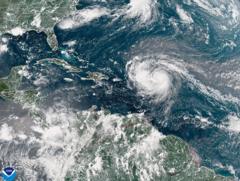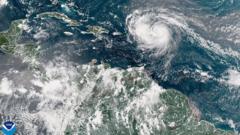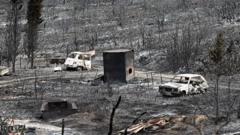**Erin emerges as a formidable storm in the 2025 Atlantic season, affecting coastal safety and inclement weather**
**Hurricane Erin Escalates to Category Five, Threatening Coastal Regions**

**Hurricane Erin Escalates to Category Five, Threatening Coastal Regions**
**Intensified hurricane exhibits unprecedented wind speeds, causing meteorological concerns**
Hurricane Erin has rapidly intensified to a category five storm, boasting destructive winds of 160 mph (260 km/h). National Hurricane Center Director Mike Brennan emphasized during a briefing that the hurricane "explosively deepened" overnight, escalating from tropical storm strength observed just days prior. This powerful storm is expected to skirt past the Leeward Islands, Virgin Islands, and Puerto Rico by the weekend, unleashing as much as 6 inches (15 cm) of rain in these regions, heightening the risk for flash flooding and mudslides.
Remarkably, Erin is the first hurricane of the 2025 Atlantic season and has demonstrated rapid intensification—a phenomenon wherein a storm strengthens by at least 34 mph within a 24-hour period. Winds surged from 100 mph early Saturday morning to the current 160 mph, as reported by Brennan. In the coming week, Erin is predicted to drift gradually northward, moving past the eastern Bahamas and towards the Outer Banks of North Carolina.
Additionally, the storm is set to generate dangerous surf and rip currents along nearly the entire East Coast of the United States next week, with Florida and mid-Atlantic states facing the most perilous conditions. Moreover, Bermuda anticipates "life-threatening" surf conditions and significant rainfall as Erin approaches. In response to escalating gale force winds, the US Coast Guard is enforcing restrictions for vessels in St Thomas and St John in the US Virgin Islands, as well as six municipalities in Puerto Rico, including San Juan.
Officials from the National Oceanic and Atmospheric Administration (NOAA) have raised alarms about an “above normal” Atlantic hurricane season. The alarming trend of tropical storms reaching category four and five intensity is projected to rise, driven by ongoing global warming.
Remarkably, Erin is the first hurricane of the 2025 Atlantic season and has demonstrated rapid intensification—a phenomenon wherein a storm strengthens by at least 34 mph within a 24-hour period. Winds surged from 100 mph early Saturday morning to the current 160 mph, as reported by Brennan. In the coming week, Erin is predicted to drift gradually northward, moving past the eastern Bahamas and towards the Outer Banks of North Carolina.
Additionally, the storm is set to generate dangerous surf and rip currents along nearly the entire East Coast of the United States next week, with Florida and mid-Atlantic states facing the most perilous conditions. Moreover, Bermuda anticipates "life-threatening" surf conditions and significant rainfall as Erin approaches. In response to escalating gale force winds, the US Coast Guard is enforcing restrictions for vessels in St Thomas and St John in the US Virgin Islands, as well as six municipalities in Puerto Rico, including San Juan.
Officials from the National Oceanic and Atmospheric Administration (NOAA) have raised alarms about an “above normal” Atlantic hurricane season. The alarming trend of tropical storms reaching category four and five intensity is projected to rise, driven by ongoing global warming.





















